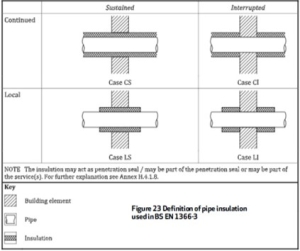What are the different types of service penetration insulation configurations? Firestopping FAQs
Chances are you’ve encountered the different service penetration insulation configurations on our detail drawings and may have wondered what they mean, especially if you’re relatively new to the construction industry. Look no further! This short article delves into the common insulation configuration types, using the recognised abbreviations outlined in the BS EN 1366-3 fire-resistance test standard.

Pipe insulation is used on service penetrations for a variety of reasons. However, there are two key industry-relevant motives.
Firstly, pipe insulation is integrated into the building’s service penetration design. Pipes may need to be insulated in certain materials. This is typically to achieve different performance aspects, such as thermal loss, meaning that both the firestop seal product and insulation typed used need to be fire tested.
Secondly, it forms an important part of the penetration seal, preventing heat transfer and ensuring the fire-resistance requirement for insulation (I) is met. Where uninsulated metal pipes are used, for example a steel sprinkler pipe, additional pipe insulation may be required to help stop the transfer of heat from one compartment to another.
Below is a breakdown of the abbreviations from the BS EN 1366-3 fire-resistance test standard for service penetrations:
- C/S – Continuous Sustained: In this configuration, insulation passes through the penetration seal and continues throughout the building.
- C/I – Continuous Interrupted: This configuration involves the insulation stopping on each side of the penetration seal but continuing throughout the building.
- L/S – Local Sustained: In this case, insulation remains continuous throughout the penetration but stops at a specified minimum distance on each side of the penetration seal, typically ranging from 300-500mm.
- L/I – Local Interrupted: Here, the insulation stops on each side of the penetration seal and at a prescribed minimum distance on each side of the penetration seal, typically 300-500mm.

Watch the video:
For any further enquiries, please don’t hesitate to reach out to us here Quelfire at technical@quelfire.co.uk, and we’ll be more than happy to help.

